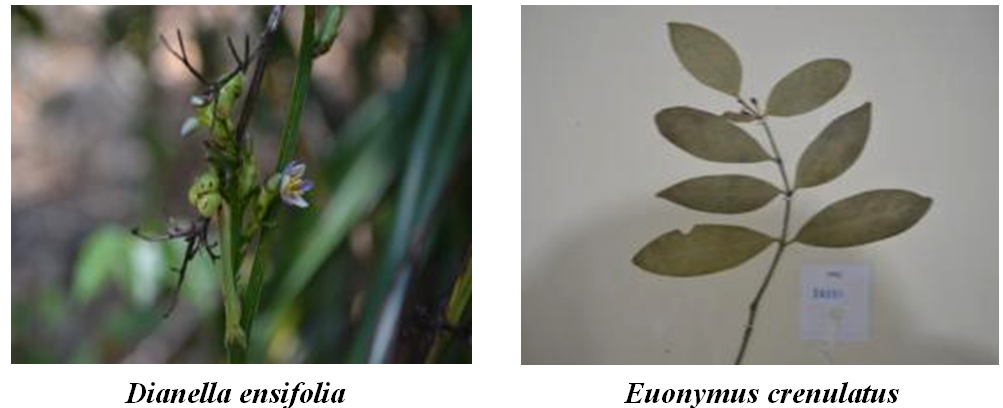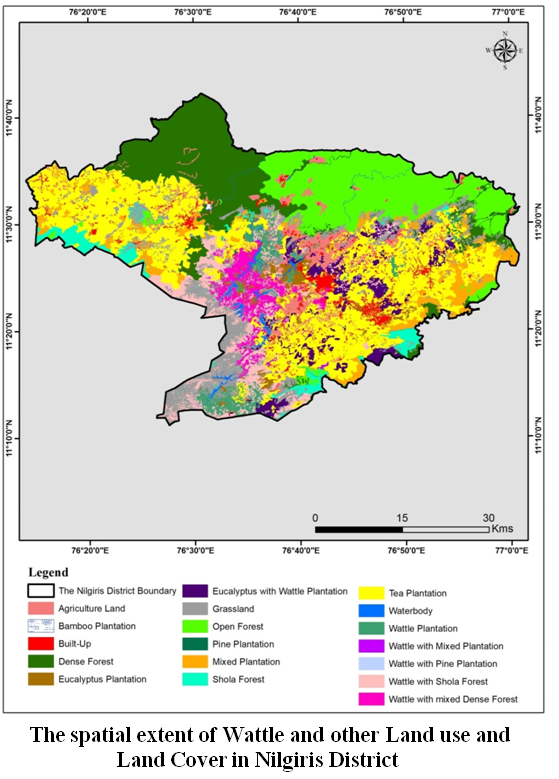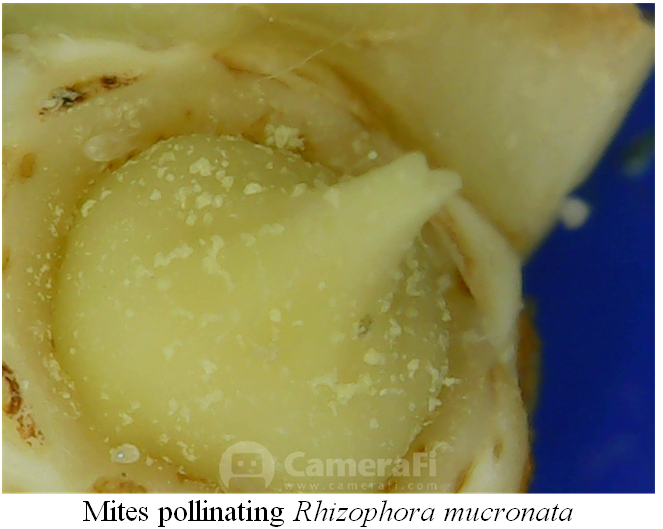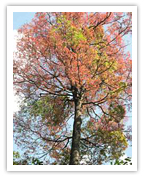Forest Ecology and Climate Change / Achievements
 |
Under the project on Plant diversity of Silent Valley Buffer zone, sponsored by Kerala Forest department, more than 1700 specimens have been collected and 560 species have been identified. Of which about 30 species can be classified as endemic to Western Ghats, 22 species with ornamental potential, 14 are wild edibles and 30 red listed ones.
 |
|||
 |
Survey and documentation of Phytodiversity in and around Singanallur Lake, Coimbatore was carried out and recorded 453 plants species.
|
|||
 |
Plant biodiversity of Silent Valley Buffer zone was documented and about 1850 plant species were collected, identified and categorized based on their utility and threatened as per the IUCN Red List.
|
|||
 |
Regeneration potential of native flora in Acacia auriculiformis plantations in 110 different Acacia auriculiformis plantations established in different years were conducted at Kerala and documented 88 native species
|
|||
 |
Two plant species such as Dianella ensifolia (L.) Redoutè and Euonymus crenulatus Wall. ex Wight & Arn. recorded as new report to the flora of Palakkad district, Kerala.
 |
|||
 |
Spatial mapping of wattle invasion in shola grassland ecosystem has been mapped using satellite images in Palni, Nilgiri Hills and Idukki. The study revealed that the extent of wattle with shola forests increased while the extent of grasslands has reduced.
 |
|||
 |
Habitats which are vulnerable for Acacia mearnsii and Prosopis juliflora invasion has been mapped using MAXENT Species Distribution Model (SDM).
 |
|||
 |
Spatial extent of Casuarina and Eucalyptus plantations has been mapped in Ariyalur, Karur, Pudukkottai, Sivagangai, Cuddalore and Villupuram districts of Tamil Nadu. The study revealed that among the various districts studied, Pudukkottai District had the largest area under eucalyptus plantations both during 2013-14 and 2016-17 (28418.86 and 38191.67 ha respectively) while Villupuram district had the largest area under Casuarina plantations (15076.21 and 20420.37 ha respectively).
|
|||
 |
Phenological responses of Teak to changing climate in Parambikulam WLS has been assessed using Moderate Resolution Imaging Spectro-radiometer (MODIS) satellite images of 19 years (2001 to 2020). The analysis showed that the number of growing days has changed in different years which need to be correlated with Temperature and Rainfall data
|
|||
 |
Visitor Carrying Capacity of four ecotourism sites (Kuruva, Chembra peak, Banasuramala-Meenmutty and Soojippara) in South Wayanad Forest Division, Kerala was assessed.
|
|||
 |
For the first time, Mites as one of the legitimate pollinator for Rhizophora mucronata has been observed during our studies on mangroves.
 |
|||
 |
Studies on Rhizophora apiculata, R. mucronata and the R. x annamalayana revealed that the hybrids are morphologically superior with high chlorophyll content and biomass.
 |
|||
 |
Selections of E.tereticornis x E.grandis and E.tereticornis x E.urophylla' derived from controlled cross full sib family were subjected to industrial evaluation for veneer preparation. Messrs. Ambiply Industries, Mettupalayam, Coimbatore District evaluated the selections and reported that the selections yielded over 80-85% of core veneer and face veneer which will be highly useful for commercial ply making industries.
 |
|||
 |
Phenotypically superior trees (92 Nos) of Dalbergia were selected from 11 forest divisions in Tamil Nadu and Kerala for clonal trial at Varavoor area of Thrissur Forest Division, Kerala. Various PCR protocols were analyzed, and standardized the PCR methods to get a high polymorphism. Among the 17 primers screened, 6 primers gave variation. Among the 6 RAPD primers, 2 have given 70% polymorphism. Significant variation in secondary metabolites like tannin, saponin, triterpenoids, phenols, and flavonoids were noticed in different plant parts as well as among different Dalbergia populations
|
|||
 |
Candidate Plus Trees (50 nos) of A.nilotica from 30 districts of the state covering 5 agro climatic zones has been assembled and three trials were established.
|
|||
 |
Candidate Plus Trees (50 nos) of A.nilotica from 30 districts of the state covering 5 agro climatic zones has been assembled and three trials were established.
|
|||
 |
Phenotypically superior trees (40 Nos) of Swietenia. macrophylla were selected from 25 populations in Tamil Nadu and Kerala. and progeny trials in Gudalur RF, Maraimalainagar, Chennai were established.
|
|||
|
Threatened species recovery research
|
||||
 |
Undertook Species Recovery Research on threatened species of medicinal plants in Silent Valley and Kolli Hills Medicinal Plant Conservation Areas (MPCA) of Kerala and Tamil Nadu, which involved the assessment of status of population of 21 threatened medicinal plants, mapping their distribution at these sites, seed biology and reproductive biology studies to develop strategy for long-term conservation of Rare Endangered and Threatened (RET) species of medicinal plants. Majority of the species showed contiguous distribution in both the sites. In general, Aphanamixis polystachya Canariun strictum, Cinnamomum sulphuratum, Embelia ribes, Glycosmis macrocarpa Hydnocarpus alpina, Nothapodytes nimmoniana, Aristolochia tagala and Raphidophora laciniata are found to be threatened in varying degrees. This study has been conducted in collaboration with State Forest Department of Kerala and Tamilnadu and Foundation for Revitalization of Rural Health Traditions (FRLHT), Bangalore.
|
|||
|
Natural Regeneration Studies in Silent valley National Park
|
||||
 |
Silent valley National Park is one of the biodiversity hot spots in India. Low elevation grasslands in the park gradually are changing into forested land. But earlier observations showed that the regeneration of trees in grasslands was slow and species coming up in the grassland were of deciduous type. But along the ecotone areas majority of species are evergreen. Due to the protection provided to the area over a period of time many changes have occurred in the vegetation. By studying the regeneration pattern among the trees and other woody elements, one can predict the future of the vegetation in the park and can suggest management measures if necessary. Keeping these facts in view this study was proposed to achieve the objectives 1). Study the dynamics of natural regeneration of woody species in different forest ecosystems in Silentvalley National Park and 2). identification of problems of regeneration specific to the dominant species through phenological, demographic and phytosociological studies.
Natural regeneration studies on important trees in Silent valley National Park are being undertaken and it is found that trees like Careya arborea, Dalbergia lanceolaria, Elaeocarpus serratus, Glochidion arboreum, Maxtixia arborea, Neolitsea scrobiculata, Phyllanthus emblica, Symplocos cochinchinensis, Syzygium cumini, Wendlandia thyrsoidea and Zyziphus rugosa regeneratewell in grassland. |
|||
|
The diversity of bee fauna of the Nilgiris
|
||||
 |
Bees form a vital part of many natural and farmed landscapes all over the world. Both as pollinators and as part of the wider insect community, their activities not only promote healthy ecosystems, but also in many cases they are essential to the life cycles of particular plant species. Bees and plants have co-evolved through millions of years of evolutionary history and both are innately interdependent for each other's survival. Bees are the best pollinators (responsible for about 80 percent pollination) of many agricultural and horticultural crops and forestry species and they play a significant role in the fertilization of flowers and improvement of quality and quantity of yield. Plants like Orchids have specialized pollinators and their absence in the ecosystem may lead to poor seed production, regeneration, dwindling of population and rarity. Bees are under pressure everywhere, both from the direct impact of pesticides in the environment as well as habitat alteration and destruction.
The Nilgiri district of Tamil Nadu form an important area of the Nilgiri Biosphere Reserve. The area has distinct phytogeographical features and shelters about 183 species of endemic, rare and endangered plant species coming under 41 families. The elevation of the area ranges from 300m to 2600m above msl. Most of the familiar types of South Indian forests are represented in the Nilgiris, together with a few that are peculiar to this hilly tract alone. Since the middle of 19th century, the hills of the Nilgiris have been the spot of large-scale plantation activities. Many plantation species/ crops (Tea, Coffee, Cinchona, Eucalyptus spp., Acacia spp., Pinus spp. etc.) were introduced and few alien invasive species (Ageratina adenophora (Eupatorium glandulosum), Ulex europeus, Cytisus scoparius, Lantana camara, var.aculeata) colonized the cleared areas. Therefore the ecosystem of the hill tracts has been modified to a great extent. This could have direct impact on the bee fauna of the area, as they are reported to be very sensitive to even minor changes in the ecosystem. Almost all the crops grown in this mountainous tract needs the pollination services from the bees for fruit / seed production and the forest plants require them for their reproductive cycles to continue and for maintaining the diversity through cross-pollination. The studies envisaged will throw light on species richness of bees and diversity, association with various plant species and the factors posing as threats to their existence, so as to evolve suitable strategies for ensuring their sustenance in the ecosystem. |
|||
|
Sacred groves of Alappuzha district, Kerala
|
||||
 |
Alappuzha is the smallest (1414 km2 area) district in Kerala with a high population density and is the only district in the state without natural forests. However, sacred groves generally known as ‘Kavu’ varying in size from small patches of few trees to many acres exist in the area and most of the them are owned by ancestral families / temple trusts. The sacred groves of the district attract utmost attention, as they are the only remnants of evergreen forests once present. Since sacred groves represent the past status of vegetation and biotic and abiotic diversity of the region, an in-depth assessment of these natural resource pockets can be an excellent tool for any regional biodiversity planning. A project entitled Status and Floristic Diversity of Sacred Groves – The Only Remnants of Natural Forests in Alappuzha District, Kerala has been funded by ICFRE.
   |
|||
Extension Activities
 |
Training on “Biological Diversity Act, 2002“, for officials of various line departments of Tamil Nadu and Kerala, sponsored by the National Biodiversity Authority (NBA), Chennai was conducted in the years 2017, 2018,2019, 2020.
|
|||
 |
Training on “ABS Guidelines“ for Scientists of different ICFRE institutes was organized on 28th and 29th January, 2020.
|
|||
 |
Celebration of Kedharnath Memorial Lecture (KML) is being organized regularly every year.
|
|||
 |
International Mangrove Conservation Day (IMCD- 21) 26th July 2021 at Pitchavaram field station was celebrated to create awareness of the significance of the ecosystem and to promote solutions for their sustainable management, conservation and uses. About 150 participants attended the program from different parts of the country through virtual and offline mode.
|
|||
 |
Conducted One day field Workshop on Mangroves for TNFD frontline field staff at Pichavaram mangrove field station, Cuddalore during August 2021.
|
|||
 |
Training course on “Prevention, control and management of invasive alien species“ for Indian Forest Service Officers ranking from APCCF to DCF, a total of 32 IFS officers from different states participated in the training, sponsored by the Ministry of Environment, Forest and Climate Change, Govt. of India, New Delhi 05-06th August, 2021.
|
|||
 |
Capacity Building Training on REDD+ Action Plan for Officers of Tamil Nadu State Forest Department for under CAMPA funded ICFRE Scheme on 6-7th January, 2022.
|
|||
 |
Capacity Building Training on REDD+ mechanism for Officers of State Forest Department, Andaman under CAMPA funded ICFRE Scheme on 17-18 February 2021.
|
|||
 |
Capacity Building Training on REDD+ Action Plan for Officers of Kerala State Forest Department for under CAMPA funded ICFRE Scheme on 15-16 March 2021.
|
|||
 |
Conservation Assessment, Management and Prioritization Workshop for Threatened Plants of Tamil Nadu organized by ICFRE-IFGTB collaboration with TBGPCCR on 26-27 September 2023
|
|||





